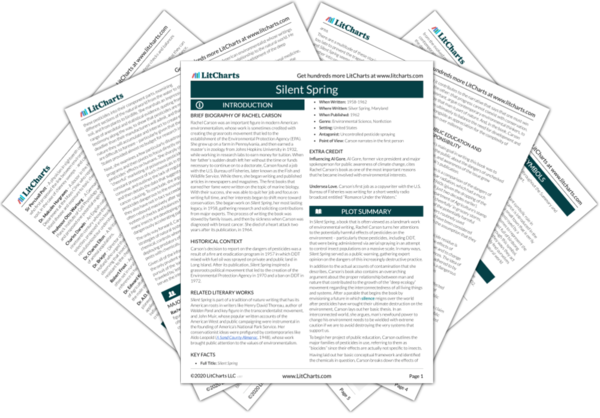Welcome to the LitCharts study guide on Rachel Carson's Silent Spring. Created by the original team behind SparkNotes, LitCharts are the world's best literature guides.
Silent Spring: Introduction
A concise biography of Rachel Carson plus historical and literary context for Silent Spring.
Silent Spring: Plot Summary
A quick-reference summary: Silent Spring on a single page.
Silent Spring: Detailed Summary & Analysis
In-depth summary and analysis of every chapter of Silent Spring. Visual theme-tracking, too.
Silent Spring: Themes
Explanations, analysis, and visualizations of Silent Spring's themes.
Silent Spring: Quotes
Silent Spring's important quotes, sortable by theme, character, or chapter.
Silent Spring: Characters
Description, analysis, and timelines for Silent Spring's characters.
Silent Spring: Symbols
Explanations of Silent Spring's symbols, and tracking of where they appear.
Silent Spring: Theme Wheel
An interactive data visualization of Silent Spring's plot and themes.
Brief Biography of Rachel Carson
Rachel Carson was an important figure in modern American environmentalism, whose work is sometimes credited with creating the grassroots movement that led to the establishment of the Environmental Protection Agency (EPA). She grew up on a farm in Pennsylvania, and then earned a master’s in zoology from Johns Hopkins University in 1932, while working in research labs to earn money for tuition. When her father’s sudden death left her without the time or funds necessary to continue on to a doctorate, Carson found a job with the U.S. Bureau of Fisheries, later known as the Fish and Wildlife Service. While there, she began writing and published articles in newspapers and magazines. The first books that earned her fame were written on the topic of marine biology. With their success, she was able to quit her job and focus on writing full time, and her interests began to shift more toward conservation. She began work on Silent Spring, her most lasting legacy, in 1958, gathering research and soliciting contributions from major experts. The process of writing the book was slowed by family issues, and then by sickness when Carson was diagnosed with breast cancer. She died of a heart attack two years after its publication, in 1964.
Get the entire Silent Spring LitChart as a printable PDF.

Historical Context of Silent Spring
Carson’s decision to report on the dangers of pesticides was a result of a fire ant eradication program in 1957 in which DDT mixed with fuel oil was sprayed on private and public land in Long Island. After its publication, Silent Spring inspired a grassroots political movement that led to the creation of the Environmental Protection Agency in 1970 and a ban on DDT in 1972.
Other Books Related to Silent Spring
Silent Spring is part of a tradition of nature writing that has its American roots in writers like Henry David Thoreau, author of Walden Pond and key figure in the transcendentalist movement, and John Muir, whose popular written accounts of the American West and public campaigning were instrumental in the founding of America’s National Park Service. Her conservationist ideas were prefigured by contemporaries like Aldo Leopold (A Sand County Almanac, 1948), whose work brought public attention to the values of environmentalism.
Key Facts about Silent Spring
- Full Title: Silent Spring
- When Written: 1958-1962
- Where Written: Silver Spring, Maryland
- When Published: 1962
- Genre: Environmental Science, Nonfiction
- Setting: United States
- Antagonist: Uncontrolled pesticide spraying
- Point of View: Carson narrates in the first person
Extra Credit for Silent Spring
Influencing Al Gore. Al Gore, former vice president and major spokesperson for public awareness of climate change, cites Rachel Carson’s book as one of the most important reasons that he became involved with environmental interests.
Undersea Love. Carson’s first job as a copywriter with the U.S. Bureau of Fisheries was writing for a short weekly radio broadcast entitled “Romance Under the Waters.”












